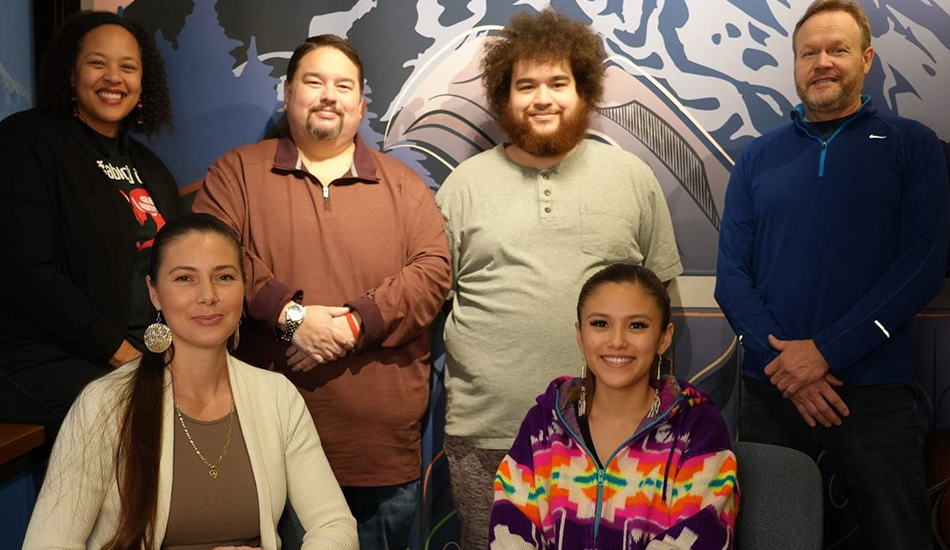By Hailey Palmer, Puyallup Tribal News
Employees of the Puyallup Tribe’s Historic Preservation Department wear many hats as they make sure the Tribe’s history is cared for properly.
Whether they are in the office taking meetings, out in the field investigating potential artifacts or taking care of the new Mini-Museum, everyone in the department plays an important role to in making sure the Tribe’s history and culture is being recorded, protected and reshared accurately in schools or the greater community.
With preservation comes education as the department is also teaching the Tribe’s history to whoever may walk through the doors looking to learn more.
Recently, Director Brandon Reynon and Assistant Director/Collections Manager Amber Taylor met with Puyallup Tribal News to discuss the inner workings of their department.
What do you want people to know about the department?
Reynon: We’re here to help them learn the history of the Tribe. I think we have one of the coolest jobs at the Tribe because we get to not only preserve history through the collection of archives, but we get to actually find and protect our history through the archaeology and cultural resource protection program. We actually get to feel the history, we get to put our hands on it.
Taylor: We support both Tribal members and the greater, larger community with research requests. When it comes to trying to learn Tribal history, if someone has a specific question we try to assist them with learning what they’re seeking.
What projects are you excited about within the department?
Taylor: I think one of the big campaigns we’ve been pushing with this department is to record oral history. One of the things we’re most excited about is collecting Tribal member stories and history.
Reynon: The reason we do that project is because … the next generations of Puyallup Tribal members are going to want to know what life was like. I think about the recordings that we have, and they’re not always from leaders, they were just Tribal members, and we got their story, and they’re so rich because they share so much. Our story may not seem important today, and the average Tribal member might be like, ‘They don’t need to hear my story,’ but yeah, we do. Whether you’re from Florida, London, California, Eastern Washington, Bellingham or Seattle, we need to know your story.”
What are some of the more interesting or cool things you’ve learned while in your roles?
Reynon: For me, learning about the sx̌ʷəbabš people, our neighbors over on Vashon. That was kind of a cool thing because they were all but forgotten really. There’s not a whole lot mentioned of them, but somebody came to Judy Wright back in 2010 saying, “I see these people listed here do you know who they were?” Now we have schools named after them over there in Gig Harbor.
Taylor: There’s this other knowledge that I’ve learned in terms of how to care for artifacts and things that the Tribe owns or has in its collection. The other really rewarding project was putting together this pilot museum, and that was my first experience putting together any kind of exhibition. So, that really makes you think about where we can go in the future. That was a very stressful time, but it was a good learning experience.
What do you most enjoy about the type of work you do?
Reynon: I enjoy educating the Tribal members. It’s really cool to have them come in and watch them as they learn. They’ll come out and talk about what they learned. It’s cool to see them become educated on parts of history. Not everybody knows all the history, so it’s great to come in and learn. It’s really cool to be able to share that knowledge with them.
Taylor: I think one of my favorite parts is finding things that are valuable to the Tribe’s history. I really enjoy researching and finding really cool articles or old photographs and adding these things into our collection for our membership to have access to. I look all over the place for stuff that we can bring back home or to other museum collections. A big goal is to repatriate.
What big projects are you working on now?
Taylor: (Membership History Liaison) Tiauna Bill is working on outreaching with Tribal members, and she’s kind of heading up the oral history campaign. (Archivist) Casey Barton is doing a huge digitization. He’s working cabinet by cabinet to digitize our archives so they’re more readily available when we get requests from out of state. We have Uzuri Hilyard who is amazing support within our department. She’s our admin assistant, and she keeps us moving forward and organized. She’s kind of the face of our department when people come in and is an awesome host when folks come and visit the museum. Mike Shong, our archaeologist, is in the field like every day.
Reynon: We have Patricia Ortiz who is with Heritage, but she works heavily with our department for the education outreach ensuring that local Native history is taught in every school grade. We have 12 school districts and Chief Leschi we work with to ensure that Puyallup history is taught accurately. There’s Jennifer Keating with the (Planning and Land Use) Department who also helps with the cultural resources. There’s so much work to do we have to branch out.
Learn more: The Historic Preservation Department can be reached at 253-573-7965. The Mini-Museum in Fife at 3700 Pacific Highway E., Suite 311, is open from 10 a.m. to 4 p.m. Tuesday through Friday. A full staff list and contact info for the department can be found at www.puyalluptribe-nsn.gov/about-our-tribe/historic-preservation.





